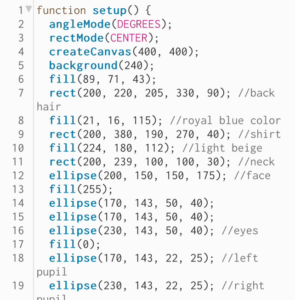Concept:
Considering my beginner coding skills and the project’s deadline, I focused on portraying recognizable features like my curly hair and glasses in my self-portrait. To achieve this, I used circles to mimic the curls of my hair and smooth squares to represent the frames of my glasses. This approach allowed me to create a clear and straightforward depiction of these key features within the technical and time constraints of the project.
A highlight of some code that you’re particularly proud of:
//Hair
noStroke()
fill(0);
arc(200, 140, 120, 100, PI, 0);
//Curls
fill("#181009")
circle(150, 120, 50)
circle(180, 120, 50)
circle(210, 120, 50)
circle(240, 120, 50)
circle(245, 120, 50)
Embedded sketch:
Reflection and ideas for future work or improvements:
In my self-portrait, I generally feel content with the overall outcome, but there are elements I now recognize could have been improved. After looking at other examples, I realized a missed opportunity in the portrayal of my glasses. I wish I had learned to isolate a specific area for the eyes that would follow the cursor, adding an interactive and dynamic aspect to the artwork.
Another aspect I would revise is the portrayal of my facial features. Initially, I used simple shapes, but now I see the potential for more accurately representing features like my eyes, nose, and mouth. With more advanced coding skills, I could have added detail to these features, making the portrait not just an abstract representation but a more recognizable portrait of myself.
However I look forward to delving deeper into the possibilities of creative coding, pushing the boundaries of what I can create and express.



